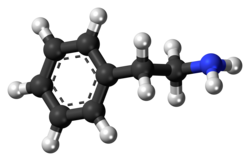Search results
Appearance
There is a page named "Selegiline" on Wikipedia
- Selegiline, also known as L-deprenyl and sold under the brand names Eldepryl, Zelapar, and Emsam among others, is a medication which is used in the treatment...209 KB (20,330 words) - 21:27, 30 March 2025
- pharmacology of selegiline pertains to the pharmacodynamic and pharmacokinetic properties of the antiparkinsonian and antidepressant selegiline (L-deprenyl)...140 KB (14,234 words) - 15:37, 27 March 2025
- brain. Rasagiline shows pharmacological differences from the related drug selegiline, including having no amphetamine-like metabolites, monoamine-releasing...89 KB (8,754 words) - 22:00, 17 March 2025
- Levomethamphetamine (category Selegiline)catecholamine releasing activity. It is 1- to 10-fold less potent than selegiline but is 3- to 5-fold more potent than dextromethamphetamine in this action...52 KB (5,121 words) - 00:47, 16 March 2025
- complicated by panic disorder or hysteroid dysphoria. Newer MAOIs such as selegiline (typically used in the treatment of Parkinson's disease) and the reversible...37 KB (4,008 words) - 01:31, 19 March 2025
- the developmental code name MK-306, is an experimental drug related to selegiline which acts as a catecholaminergic activity enhancer (CAE). PPAP is a CAE...31 KB (3,138 words) - 03:56, 17 February 2025
- Levoamphetamine (category Selegiline)levoamphetamine is a known active metabolite of certain other drugs, such as selegiline (L-deprenyl). Levoamphetamine has been used in the treatment of attention...69 KB (6,422 words) - 19:19, 30 March 2025
- pseudoephedrine), antidepressants (e.g. bupropion), antiparkinson agents (e.g., selegiline), and vasopressors (e.g., ephedrine), among others. Many of these psychoactive...56 KB (5,426 words) - 13:35, 30 March 2025
- developmental code name FPFS-1169) is an experimental drug related to selegiline which acts as a monoaminergic activity enhancer (MAE). It is orally active...30 KB (2,842 words) - 04:00, 15 March 2025
- substituted amphetamine designer drug. It is the 4-fluorinated derivate of selegiline. 4-Fluoroselegiline is a selective and irreversible inhibitor of monoamine...6 KB (331 words) - 18:39, 15 January 2025
- phentermine, mephentermine, tranylcypromine, bupropion, methoxyphenamine, selegiline, amfepramone (diethylpropion), pyrovalerone, MDMA (ecstasy), and DOM (STP)...36 KB (1,763 words) - 00:06, 9 April 2025
- Deprenyl (category Selegiline)N-propargylmethamphetamine, is the racemic mixture of D-deprenyl and L-deprenyl (selegiline). It was discovered in 1961 in Hungary at Chinoin Pharmaceutical Company...7 KB (517 words) - 21:27, 30 March 2025
- Monoaminergic activity enhancer (category Selegiline)serotonergic activity. Selegiline's metabolite desmethylselegiline has also been found to be active as a CAE. Aside from selegiline and its metabolites,...58 KB (5,947 words) - 10:58, 16 February 2025
- József Knoll (category Selegiline)developing the antiparkinsonian and antidepressant drug selegiline (L-deprenyl). He developed selegiline in the 1960s and subsequently studied the drug and...7 KB (574 words) - 11:26, 13 November 2024
- similar potency. This is similar to BPAP, but is in contrast to PPAP and selegiline, which act exclusively as catecholaminergic activity enhancers (CAEs)...10 KB (744 words) - 09:14, 18 March 2025
- phenethylamine-derived selegiline (L-deprenyl) and phenylpropylaminopentane (PPAP). This suggests that different MAEs like BPAP and selegiline may not be identical...11 KB (1,210 words) - 22:54, 18 November 2024
- non-selective MAOI linezolid and the potent selective MAO-B inhibitor selegiline (as a transdermal patch) on the pharmacokinetics of pseudoephedrine. This...147 KB (13,453 words) - 00:12, 2 April 2025
- enantiomers of deprenyl and is the opposite enantiomer of l-deprenyl (selegiline). l-Deprenyl, also an MAO-B inhibitor, metabolizes to l-amphetamine and...7 KB (501 words) - 21:27, 30 March 2025
- Phenoxypropazine (Drazine) Pivhydrazine (Tersavid) Safrazine (Safra) Selegiline (Eldepryl, Zelapar, Emsam) – also a catecholaminergic activity enhancer...18 KB (1,531 words) - 17:08, 22 February 2025
- Management of Parkinson's disease (section Selegiline)oscillations in some patients. Dietary protein restriction and the use of selegiline and bromocriptine may also temporarily improve motor fluctuations. New...75 KB (8,902 words) - 05:33, 17 March 2025
- on: selegiline Wikipedia Probably from sele(ctive) + -giline (“MAO inibitor type B”). (General American) IPA(key): /səˈlɛd͡ʒ.ɪˌlin/ selegiline (uncountable)
- the effects that Selegiline and its metabolites has on nicotine metabolism. In this article, the researchers took a look at Selegiline (L-deprenyl), which
















